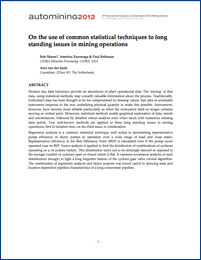2012 Automining • Use of Common Statistical Techniques
On the Use of Common Statistical Techniques to Long Standing Issues in Mining Operations
Modern day data historians provide an abundance of plant operational data. The ‘mining’ of that data, using statistical methods, may unearth valuable information about the process. Traditionally, instrument data has been thought to be too compromised by missing values, bad data or unreliable instrument response to the true underlying physical quantity to make this possible. Instruments, however, have become more reliable particularly so when the instrument itself no longer contains moving or wetted parts. Moreover, statistical methods enable graphical exploration of data, trends and interrelations, followed by detailed robust analysis even when faced with numerous missing data points. Two well-known methods are applied to three long standing issues in mining operations, first in isolation then, on the third issue, in combination.
Regression analysis is a common statistical technique well suited to determining representative pump efficiency of slurry pumps in operation over a wide range of load and wear states. Representative efficiency at the Best Efficiency Point (BEP) is calculated even if the pump never operated near its BEP. Factor analysis is applied to find the distribution of combinations of cyclones operating on a 14 cyclone battery. This distribution turns out to be strikingly skewed as opposed to the average number of cyclones open or closed which is flat. A variance-covariance analysis of such distributions brought to light a long forgotten feature of the cyclone gate valve control algorithm. The combination of regression analysis and factor analysis was found useful in deriving state and location dependent pipeline characteristics of a long concentrate pipeline.

